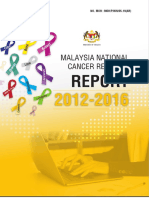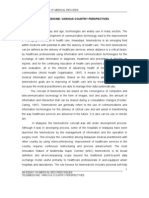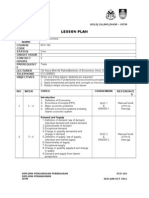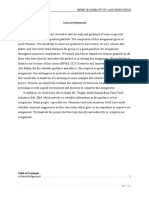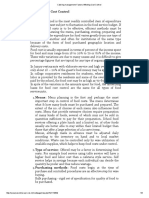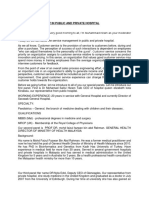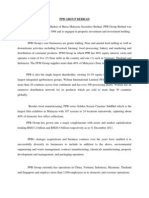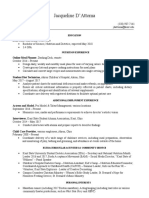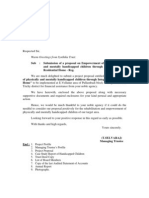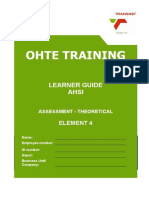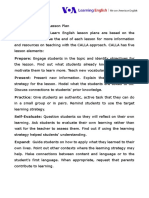Professional Documents
Culture Documents
Provoking "Eureka" Moments For Effective Infection Control Strategies
Uploaded by
Claude SUPEROriginal Title
Copyright
Available Formats
Share this document
Did you find this document useful?
Is this content inappropriate?
Report this DocumentCopyright:
Available Formats
Provoking "Eureka" Moments For Effective Infection Control Strategies
Uploaded by
Claude SUPERCopyright:
Available Formats
World Hospitals and Health Services Vol. 50 No.
2 7
Infection prevention and control
S
ince antiquity, health care-associated infection has been a
reality and a source of suffering for countless millions of
patients and their families worldwide, but patient safety has
only really become a major topic over the past 1015 years.
Despite a body of constantly expanding research, many questions
still remain. For example, the reasons for the uneven geographic
distribution of infection rates are not fully understood, notably the
striking differences in the epidemiology of nosocomial infections
and multiresistant bacteria between the United States and Europe.
Disparities may be explained by several determinants:
: surveillance methods, including diagnostic practices and
laboratory recognition;
: infection control practices;
: antibiotic prescribing practices;
: population characteristics and patient case-mix;
: cultural factors (e.g., human behaviour);
: factors related to the health care systems and available
resources;
: political commitment.
Clearly, the effects exerted at the macrolevel by the health care
system and the political environment contribute substantially to the
observed differences in infection rates, but these should serve also
as an additional incentive to drive forward innovation and creative
thinking for new preventive strategies.
Current conceptual thinking on patient safety places the prime
responsibility for adverse events on defects in system design,
organization and operation, rather than on individual providers or
individual products. Most adverse events, such as health care-
associated infection, are not the result of negligence or lack of
training, but rather occur because of latent causes within systems.
Safety is a fundamental principle of patient care and a critical
component of quality management. Infection control is the
DIDIER PITTET
DIRECTOR, INFECTION CONTROL PROGRAMME AND WHO COLLABORATING CENTRE ON PATIENT SAFETY, UNIVERSITY OF
GENEVA HOSPITALS AND FACULTY OF MEDICINE, SWITZERLAND AND LEAD ADVISOR, FIRST GLOBAL PATIENT SAFETY
CHALLENGE, WHO PATIENT SAFETY AND QUALITY IMPROVEMENT UNIT, SERVICE DELIVERY AND SAFETY DEPARTMENT,
WORLD HEALTH ORGANIZATION, GENEVA, SWITZERLAND
Provoking Eureka moments for
effective infection control strategies
entrance door to patient safety and innovative strategies need to
be developed. However, most great ideas are not the result of a
flash of inspiration they are rather the result of hard efforts, team
work and conflict. Eureka moments do not happen overnight.
The Geneva hand hygiene model: A breakthrough innovation
In the mid-1990s, initial observation studies in Geneva showed a
low compliance with basic hand hygiene practices and a lack of
awareness by health care workers that the main cause of cross-
transmission of microorganisms is by hands (1). Time constraint
was identified as the major determinant for poor compliance (2).
The challenge was to facilitate hand hygiene for staff and to find an
innovative way to do so. We tried to think out of the box and to see
if perhaps there were sources of inspiration outside the infection
control field. This led us to investigate concepts from the social
sciences to help understand the main determinants driving health
care worker behaviour and that led to the creation of a multimodal
strategy. My own Eureka moment was when I realized that the
key component was obviously the introduction of alcohol-based
hand rub at the point of patient care to replace handwashing at the
sink (system change), thus bypassing the time constraint
imposed by handwashing (3).
Driving commitment to fight health care-associated infection
The first multimodal intervention ran from 1995 to 1998 at the
University of Geneva Hospitals with a spectacular decrease of 50%
in hospital-associated infections and almost 80% in methicillin-
resistant Staphylococcus aureus transmission in parallel with a
sustained improvement in compliance with hand hygiene. The
methodology and results were published in the Lancet in 2000 with
a tremendous impact and the strategy soon became known in the
scientific literature as The Geneva hand hygiene model (3).
Furthermore, the strategy proved to be largely cost-effective when
ABSTRACT: Safety is now a fundamental principle of patient care and a critical component of quality management. Health
care-associated infection prevention strategies need to be constantly revisited and updated to be effective. The Geneva
hand hygiene model is a typical example of a breakthrough innovatory campaign that caught fire and went viral
worldwide, thanks to its adoption by the World Health Organization (WHO) as the First Global Patient Safety Challenge.
The campaign remains an inspiration for further innovation. To encourage new and disruptive technologies with the
potential to improve patient safety through the successful implementation of the WHO multimodal strategy, the University
of Geneva Hospitals/WHO Collaborating Centre on Patient Safety, together with the Aesculap Academy, have created a
series of Hand Hygiene Excellence Awards and Hand Hygiene Innovation Awards worldwide.
07-13 Pittett_March 2014 11/07/2014 14:06 Page 7
Infection prevention and control
8 World Hospitals and Health Services Vol. 50 No. 2
assessed after eight years, with cost savings reaching US$ 24
million per year in the early phase (4). In 2002, the United Kingdom
converted to The Geneva model and built up the national
CleanYourHands campaign, which proved to be both successful
and cost-effective. Today, for US$ 1 invested, the return on
investment is at least US$ 20.
In 2004, I was approached by the World Health Organization to
disseminate and export our multimodal strategy worldwide under
the banner of the WHO First Global Patient Safety Challenge
Clean Care is Safer Care (5). The mandate was to galvanise
global commitment among nations and policy-makers to tackle
health care-associated infection, which had been identified as a
significant area of risk for patients in all 194 Member States, with
hand hygiene as the cornerstone of the Challenge. In 2009, WHO
added a Save Lives: Clean Your Hands initiative that attracted the
adhesion of more than 17,000 health care facilities worldwide as of
May 2014. Among the flagships of the implementation strategy, the
two most popular cues for action are the posters promoting When
to handrub as described in My five moments for hand hygiene
(6, 7) and now translated in more than 100 languages throughout
the world and How to handrub, now featured in more than 100
hand hygiene dance videos from all continents (see videos (8,9))
(Figures 1 and 2).
Promoting a climate to inspire inovation and improve
infection control
To encourage new and disruptive technologies with the potential to
improve patient safety through the successful implementation of
the WHO multimodal strategy, the University of Geneva Hospitals
and the WHO Collaborating Centre on Patient Safety, in
conjunction with the Aesculap Academy, have created a series of
Hand Hygiene Excellence Awards and Hand Hygiene Innovation
Awards worldwide: in the Asia-Pacific region since 2010, in
Europe since 2012, and in Latin America in 2014. These Awards
are conceived as a platform to identify, recognize, honour and
celebrate those hospitals and health care worker groups who have
contributed to improving patient safety through their excellence,
enthusiasm and innovatory methods. A unique process has been
developed for the Awards. First, the hospitals use the WHO-
developed Hand Hygiene Self-Assessment Framework
(http://www.who.int/gpsc/5may/hhsa_framework/en/), a systematic,
validated tool to obtain a situation analysis of hand hygiene
promotion and practices within an individual health care facility (10,
11, 12). Based on their score and other criteria, selected hospitals
are visited by two members of the international panel of leading
infection control experts. Finalists then undergo a half-day visit of
experts for further evaluation of their programmes against set
criteria for creativity, innovation and local/regional leadership. A
large number of tools, based on evidence and the results of
implementation worldwide (13, 14) are available for health care
settings to improve their scores towards achieving excellence in
patient safety. Award winners in the respective regions are listed in
Table 1.
Another innovation has been the designation of Global Hand
Hygiene Expert Centres by the WHO Collaborating Centre on
Patient Safety in recognition of outstanding efforts to promote hand
hygiene excellence. In 2011, the Singapore General Hospital
(Singapore), Queen Mary Hospital (Hong Kong, S.A.R), and the
Austin Health Hospital (Australia) received this nomination for the
Asia Pacific region. In June 2013, The Charit University Hospital
(Berlin, Germany) received the award for the Europe region.
Experts from these centres visit hospitals in their regions to allocate
excellence awards and suggest further improvements.
Mobilizing patients and raising public awareness
Among the next challenges to improve patient safety are
considering patients as partners and raising public awareness of
the critical importance of optimizing both institutional systems and
Figure 1: My 5 moments for hand hygiene
Region Year Health care institution
Asia Pacific 2010 Artemis Health Institute
Haryana / India
Monash Medical Centre
Clayton (VIC) / Australia
2011 Dr Sardjito General Hospital
Yogyakarta / Indonesia
National Taiwan University Hospital
Taipei City / Taiwan, R.O.C.
2012 Bethesda Hospital
Claremont (W.A.) / Australia
West China Hospital of Sichuan University
Sichuan / R.O.C.
Cho Ray Hospital
Ho Chi Minh City / Viet Nam
Hong Kong Baptist Hospital
Kowloon / Hong Kong, S.A.R
Europe 2013 Mater Private Hospital
Dublin / Republic of Ireland
Spitalul Sf. Constantin
Brasov / Romania
Latin/Central America 2014 86 applications have been received
The Award will be presented in August 2014
Table 1: Hand hygiene excellence award winners
www.handhygieneexcellenceaward.com
07-13 Pittett_March 2014 11/07/2014 14:06 Page 8
World Hospitals and Health Services Vol. 50 No. 2 9
Infection prevention and control
health care staff behaviour. The odyssey of hand hygiene
promotion has been recently addressed in a book for the lay public
authored by the French writer Thierry Crouzet and published on 5
May 2014 WHO World Hand Hygiene Day in six languages (15).
The foreword of the book is co-authored by Dr Margaret Chan,
WHO Director-General, and Sir Liam Donaldson, WHO Patient
Safety Envoy. The book reveals also a new path open to human
society, from a predatory economy system to an economy of
peace.
Conclusion
Strong advocacy and leadership with an inherent innovatory
capacity are required to maintain patient safety high on the political
agenda, particularly in resource-poor countries where there are
many competing priorities. The challenge is to develop strategies
and campaigns with a potential for adaptability to diverse cultures
and varying resources. o
Professor Didier Pittet is the Director of the Infection Control
Programme and WHO Collaborating Centre on Patient Safety at
the University of Geneva Hospitals and Faculty of Medicine,
Switzerland. He is also the lead adviser of the WHO Global
Patient Safety Challenge Clean Care is Safer Care, currently
active in 171 of the 194 WHO Member States. In 2007, he was
awarded an honorary CBE by HM Queen Elizabeth II for services
to the prevention of health care-associated infections in the
United Kingdom.
References
1. Pittet D, Dharan S, Touveneau S, Sauvan V, Perneger TV. 1999. Bacterial contamination of
the hand of hospital staff during routine patient care. Archives of Internal Medicine 159:
821-826.
2. Pittet D, Mourouga P, Perneger TV, and the Members of the Infection Control Program.
1999. Compliance with handwashing in a teaching hospital. Annals of Internal Medicine
130: 126-130.
3. Pittet D, Hugonnet S, Harbarth S, Mourouga P, Sauvan V, Touveneau S, Perneger TV. 2000.
Effectiveness of a hospital-wide programme to improve compliance with hand hygiene.
Lancet 356: 1307-1312.
4. Pittet D, Sax H, Hugonnet S, Harbarth S. 2004. Cost implications of successful hand
hygiene promotion. Infection Control & Hospital Epidemiology 25: 264-266.
5. Pittet D, Donaldson L. 2005. Clean Care is Safer Care: a worldwide priority. Lancet
366:1246-1247.
6. Pittet D, Allegranzi B, Sax H, Dharan S, Pessoa-Silva CL, Donaldson L, Boyce JM. 2006.
Evidence-based model for hand transmission during patient care and the role of improved
practices. Lancet Infectious Diseases 6: 641-652.
7. Sax H, Allegranzi B, Uckay I, Larson E, Boyce J, Pittet D. 2007. My five moments for hand
hygiene: a user-centred design approach to understand, train, monitor and report hand
hygiene. Journal of Hospital Infection 67: 9-21.
8. World Health Organization/University of Geneva Hospitals. V1- Hand hygiene dance.
http://tinyurl.com/HandHygieneDanceWHOGeneva
9. University of Geneva Hospitals. V2- Hand hygiene: from rubbing to dancing.
http://tinyurl.com/HandHygieneRubToDance
10. World Health Organization. Hand hygiene self-assessment framework. 2010. Available at:
http://www.who.int/gpsc/country_work/hhsa_framework_October_2010.pdf. Accessed
December 12, 2013.
11. Stewardson AJ, Allegranzi B, Perneger TV, Attar H, Pittet D. 2013. Testing the WHO hand
hygiene self-assessment framework for usability and reliability. Journal of Hospital Infection
83: 30-35.
12. Allegranzi B, Conway L, Larson E, Pittet D. 2014. Status of the implementation of the
World Health Organization multimodal hand hygiene strategy in United States of America
healthcare facilities. American Journal of Infection Control 42: 224-230.
13. World Health Organization. WHO guidelines on hand hygiene in healthcare. 2009. Available
at: http://whqlibdoc.who.int/publications/2009/9789241597906_eng.pdf. Accessed May 22,
2014.
14. World Health Organization. Guide to implementation: a guide to the implementation of the
WHO multimodal hand hygiene improvement strategy. 2009. Available at:
http://www.who.int/gpsc/5may/Guide_to_Implementation.pdf. Accessed May 22, 2014.
15. Crouzet T. Clean Hands Save Lives, Editions lAge dHomme, 2014 (T. Clegg & T. Crouzet),
ISBN 978-2-8251-4432-9. Available in 6 languages also from http://blog.tcrouzet.com/
le-geste-qui-sauve/downloads/
Figure 2: How to handrub
07-13 Pittett_March 2014 11/07/2014 14:06 Page 9
You might also like
- Peranan Jururawat Dalam Perawatan KecemasanDocument5 pagesPeranan Jururawat Dalam Perawatan KecemasanSiti NoorNo ratings yet
- MNCR 2012-2016 Final (Published 2019) PDFDocument116 pagesMNCR 2012-2016 Final (Published 2019) PDFWei Ying TanNo ratings yet
- Tele MedicineDocument12 pagesTele MedicineNoorul Faedzah RosliNo ratings yet
- Parapharasing PracticeDocument24 pagesParapharasing PracticeHashwini100% (1)
- Professional boundaries and moral obligations in healthcareDocument56 pagesProfessional boundaries and moral obligations in healthcarealongjim100% (1)
- Eco 162 5Document3 pagesEco 162 5Syafiqul AsyrafNo ratings yet
- Stoke Fall PrecautionDocument31 pagesStoke Fall Precautionsmartie_chai100% (1)
- Act 436 Midwives Act 1966Document20 pagesAct 436 Midwives Act 1966Adam Haida & CoNo ratings yet
- Jaundice 20 PDFDocument54 pagesJaundice 20 PDFHaziq KamardinNo ratings yet
- Knowledge, Awareness and Perception On Contraception Among Women of Reproductive Age Attending Senawang Health ClinicDocument7 pagesKnowledge, Awareness and Perception On Contraception Among Women of Reproductive Age Attending Senawang Health Clinic2A - Nicole Marrie Honrado100% (1)
- RHB Company ProfileDocument5 pagesRHB Company ProfileKhaleel Khusairi100% (1)
- The Employment Act 1955Document4 pagesThe Employment Act 1955Yusazrin WmsNo ratings yet
- Pbe 1 HciDocument3 pagesPbe 1 HciArul Velan100% (1)
- Universiti Teknologi Mara Final Examination: Confidential BM/APR 2011/MKT547/546Document3 pagesUniversiti Teknologi Mara Final Examination: Confidential BM/APR 2011/MKT547/546zatieykarimNo ratings yet
- Physics Folio... Simple2 Yg MungkinDocument15 pagesPhysics Folio... Simple2 Yg MungkinMuhammad HaikalNo ratings yet
- CCROPP Best Pract Obesity Prev TMT PDFDocument288 pagesCCROPP Best Pract Obesity Prev TMT PDFharunnuranNo ratings yet
- PP v. KALAISELVANDocument28 pagesPP v. KALAISELVANmerNo ratings yet
- BENGKEL QA 2014: PROSES PEMILIHAN INDIKATORDocument77 pagesBENGKEL QA 2014: PROSES PEMILIHAN INDIKATORSenthil Kumar KNo ratings yet
- Acknowledgement: Bpme 2023creativity and InnovationDocument15 pagesAcknowledgement: Bpme 2023creativity and Innovationwong68040% (1)
- Euthanasia MalaysiaDocument15 pagesEuthanasia MalaysianazihaNo ratings yet
- Catering Management - Factors Affecting Cost ControlDocument6 pagesCatering Management - Factors Affecting Cost ControlPraveen100% (2)
- 1 Physical Distribution SystemDocument25 pages1 Physical Distribution SystemShubham AgarwalNo ratings yet
- Muslim Friendly TourismDocument9 pagesMuslim Friendly TourismIzzat Amsyar100% (1)
- Causes and Effects of The Popularity of Fast Food Restaurants and Fast FoodsDocument1 pageCauses and Effects of The Popularity of Fast Food Restaurants and Fast Foodsrohit raj100% (1)
- Universiti Teknologi Mara: Confidential 1 LG/APR 2019/ELC231/230/SET 2Document8 pagesUniversiti Teknologi Mara: Confidential 1 LG/APR 2019/ELC231/230/SET 2Noroi 982000No ratings yet
- Top Glove Human Resources Presentation PDFDocument21 pagesTop Glove Human Resources Presentation PDFHALIZANo ratings yet
- MCQ SelfDocument11 pagesMCQ SelfFaidz FuadNo ratings yet
- Islamic Entrepreneurship Focus On Eight Principles of ThoughtsDocument3 pagesIslamic Entrepreneurship Focus On Eight Principles of ThoughtsYufiza Mohd Yusof100% (1)
- Senarai Plaza Tol Di MalaysiaDocument18 pagesSenarai Plaza Tol Di Malaysia'HaikalKhanNo ratings yet
- Srt603-Mohamad Muhaimin Bin Mohamad AzamDocument14 pagesSrt603-Mohamad Muhaimin Bin Mohamad AzamMuhaimin AzamNo ratings yet
- Ent300 Individual AssignmentDocument13 pagesEnt300 Individual Assignmentliaaddeanna100% (1)
- WEBINAR REPORT Public Financial Management Industry Players Views Converted by AbcdpdfDocument9 pagesWEBINAR REPORT Public Financial Management Industry Players Views Converted by AbcdpdfNajib IsahakNo ratings yet
- MOH Systemic Protocol 2016Document184 pagesMOH Systemic Protocol 2016ywNo ratings yet
- Controlling Material Structure for Desired PropertiesDocument3 pagesControlling Material Structure for Desired PropertiesNorazilah YunusNo ratings yet
- PHY098 Problem Solving Skill Assignment GP1 S51Document11 pagesPHY098 Problem Solving Skill Assignment GP1 S51Harith HaikalNo ratings yet
- JTP 3.0 Sponsorship Proposal SummaryDocument10 pagesJTP 3.0 Sponsorship Proposal Summarygkboon89No ratings yet
- Malaysia's National Service Program Aims to Foster Unity Among YouthDocument8 pagesMalaysia's National Service Program Aims to Foster Unity Among YouthSim Mong KimNo ratings yet
- Law Relating To Healthcare (Law570)Document5 pagesLaw Relating To Healthcare (Law570)Serena JamesNo ratings yet
- First ResponderDocument19 pagesFirst ResponderKimGaryNo ratings yet
- PRO600 Assignment ListDocument3 pagesPRO600 Assignment ListAisyah HusnaNo ratings yet
- Sqqs1013 Elementary Statistics (Group A) SECOND SEMESTER SESSION 2019/2020 (A192)Document13 pagesSqqs1013 Elementary Statistics (Group A) SECOND SEMESTER SESSION 2019/2020 (A192)Liew Chi ChiengNo ratings yet
- Forum ScriptDocument13 pagesForum ScriptNizam LDuNo ratings yet
- Baitulmal InstitutionDocument18 pagesBaitulmal InstitutionSyed Ktwenty100% (3)
- ProposalDocument34 pagesProposalIlliani FazrienNo ratings yet
- Oldtown White Coffee InfoDocument3 pagesOldtown White Coffee Infomahadi bin suboh0% (1)
- Industrial Microbiology Lab 1 (BTC4205)Document23 pagesIndustrial Microbiology Lab 1 (BTC4205)Jerry CaldwellNo ratings yet
- Latest Students Complete Module - Updated 06102021Document108 pagesLatest Students Complete Module - Updated 06102021David ChiewNo ratings yet
- Understanding Statistics with Real-World ExamplesDocument9 pagesUnderstanding Statistics with Real-World ExamplesNurul Farhan IbrahimNo ratings yet
- PPB Group Berhad (Analysed)Document8 pagesPPB Group Berhad (Analysed)fikri86No ratings yet
- KPJ Healthcare Berhad: Nurain Syuhada Nurul Fatiha Norfaliana Nurul Ain Siti Nurhakimah Nur EmeldaDocument7 pagesKPJ Healthcare Berhad: Nurain Syuhada Nurul Fatiha Norfaliana Nurul Ain Siti Nurhakimah Nur EmeldaIeda RahmanNo ratings yet
- Skop Kerja / Peranan Dan Tanggungjawab CalonDocument2 pagesSkop Kerja / Peranan Dan Tanggungjawab CalonHaziq Aiman100% (2)
- The HokunalinDocument2 pagesThe HokunalinLiea-chanNo ratings yet
- Sugar Bun Destination CentersDocument16 pagesSugar Bun Destination CentersHuong ZamNo ratings yet
- Public SpeakingDocument3 pagesPublic Speakingjoejm33% (3)
- Asas Kewangan Sem 1Document22 pagesAsas Kewangan Sem 1Nurul AinNo ratings yet
- Effect of Implementing Nursing Care Guidelines On Nurses Knowledges and Practices Regarding External Fixation in Orthopedic PatientsDocument12 pagesEffect of Implementing Nursing Care Guidelines On Nurses Knowledges and Practices Regarding External Fixation in Orthopedic PatientsIJAR JOURNALNo ratings yet
- Mamasab Bakery Rev 1Document3 pagesMamasab Bakery Rev 1Raja Noorlyana Raja HaronNo ratings yet
- Making sentences with Chinese wordsDocument4 pagesMaking sentences with Chinese wordsHaziq Aris SaruNo ratings yet
- Who Guidelines-Handhygiene SummaryDocument64 pagesWho Guidelines-Handhygiene SummaryprofflesNo ratings yet
- WHO IER PSP 2009.07 EngDocument64 pagesWHO IER PSP 2009.07 EngHotma Uli SiahaanNo ratings yet
- Planned Parenthood of Illinois 2022Document20 pagesPlanned Parenthood of Illinois 2022Kate AndersonNo ratings yet
- Random Thoughts of A Random TeenagerDocument10 pagesRandom Thoughts of A Random Teenagervishal aggarwalNo ratings yet
- Jacqueline Dattoma - ResumeDocument2 pagesJacqueline Dattoma - Resumeapi-384691903No ratings yet
- Investment Strategies and Portfolio ManagementDocument9 pagesInvestment Strategies and Portfolio ManagementRubi ZimmermanNo ratings yet
- Employee's Profile: Little Child Jesus Christian Academy Cabiao, Nueva Ecija, IncDocument2 pagesEmployee's Profile: Little Child Jesus Christian Academy Cabiao, Nueva Ecija, IncEuniceNo ratings yet
- E - PortfolioDocument46 pagesE - PortfolioAlondra A. MatibagNo ratings yet
- Top 12 Brain-Based Reasons Why Music As Therapy Works: Karen MerzenichDocument5 pagesTop 12 Brain-Based Reasons Why Music As Therapy Works: Karen MerzenichpitamberrohtanNo ratings yet
- TeambuildingDocument18 pagesTeambuildingsamir2013100% (1)
- NLRB DocumentDocument55 pagesNLRB DocumentZoe GallandNo ratings yet
- Synthika DocumentsDocument74 pagesSynthika Documentsje82929408No ratings yet
- Affirmative ActionDocument23 pagesAffirmative ActionUtkarsh Mani TripathiNo ratings yet
- Housekeeping NC Ii Clean and Prepare Rooms For Incoming Guests (40 HOURS) Study GuideDocument3 pagesHousekeeping NC Ii Clean and Prepare Rooms For Incoming Guests (40 HOURS) Study GuideSherwin Evangelista100% (1)
- MYP Genetics unit plannerDocument5 pagesMYP Genetics unit plannerashokNo ratings yet
- Learning Difficulties 1 - PrintableDocument20 pagesLearning Difficulties 1 - PrintableNona AliNo ratings yet
- Houran - Do Online Matchmaking Tests WorkDocument21 pagesHouran - Do Online Matchmaking Tests Workyasirzaidi1No ratings yet
- Critical ReadingDocument2 pagesCritical ReadingAngelie Imperial100% (1)
- CUET Maths Domain Chapter Wise: MixedDocument19 pagesCUET Maths Domain Chapter Wise: MixedDivyansh Singh BaghelNo ratings yet
- Research Methodology Lecture 1Document2 pagesResearch Methodology Lecture 1MartinNo ratings yet
- Ahsi - Assm Theory Element 4Document3 pagesAhsi - Assm Theory Element 4Ayanda MdluliNo ratings yet
- THE ELEMENTS OF TEACHING AND LEARNING (The Learners)Document21 pagesTHE ELEMENTS OF TEACHING AND LEARNING (The Learners)Era0% (1)
- Bopps - Lesson Plan Surv 2002Document1 pageBopps - Lesson Plan Surv 2002api-539282208No ratings yet
- AktiBangsa Social Media Fellowship - Survey ResultsDocument6 pagesAktiBangsa Social Media Fellowship - Survey ResultsMisuari AbdullahNo ratings yet
- Guidance for internal audit standards implementationDocument8 pagesGuidance for internal audit standards implementationkaranziaNo ratings yet
- Chapter 7Document12 pagesChapter 7Mike SerafinoNo ratings yet
- Предметно-интегрированное обучение (Clil: Content And Language Integrated Learning) английскому языку на основе применения дистанционных образовательных технологийDocument45 pagesПредметно-интегрированное обучение (Clil: Content And Language Integrated Learning) английскому языку на основе применения дистанционных образовательных технологийНазерке ЧабденоваNo ratings yet
- Lesson 14Document16 pagesLesson 14Khmer Music100% (1)
- AIDET Competency Assessment ToolDocument2 pagesAIDET Competency Assessment ToolJenrhae LimNo ratings yet
- REVISED - Teamwork Reflection - UNIT 10 PMAL - AAKASHDocument5 pagesREVISED - Teamwork Reflection - UNIT 10 PMAL - AAKASHjackfcuk1No ratings yet
- LiteratureDocument6 pagesLiteratureMohammed EcoNo ratings yet
- WISC-IV Guide Unveils Changes to Intelligence TestDocument80 pagesWISC-IV Guide Unveils Changes to Intelligence TestCadariu MihaelaNo ratings yet
- War on Ivermectin: The Medicine that Saved Millions and Could Have Ended the PandemicFrom EverandWar on Ivermectin: The Medicine that Saved Millions and Could Have Ended the PandemicRating: 4 out of 5 stars4/5 (7)
- Uncontrolled Spread: Why COVID-19 Crushed Us and How We Can Defeat the Next PandemicFrom EverandUncontrolled Spread: Why COVID-19 Crushed Us and How We Can Defeat the Next PandemicNo ratings yet
- Summary: The Myth of Normal: Trauma, Illness, and Healing in a Toxic Culture By Gabor Maté MD & Daniel Maté: Key Takeaways, Summary & AnalysisFrom EverandSummary: The Myth of Normal: Trauma, Illness, and Healing in a Toxic Culture By Gabor Maté MD & Daniel Maté: Key Takeaways, Summary & AnalysisRating: 4 out of 5 stars4/5 (9)
- There Are No Accidents: The Deadly Rise of Injury and Disaster—Who Profits and Who Pays the PriceFrom EverandThere Are No Accidents: The Deadly Rise of Injury and Disaster—Who Profits and Who Pays the PriceRating: 4.5 out of 5 stars4.5/5 (15)
- Do You Believe in Magic?: The Sense and Nonsense of Alternative MedicineFrom EverandDo You Believe in Magic?: The Sense and Nonsense of Alternative MedicineNo ratings yet
- The Wisdom of Plagues: Lessons from 25 Years of Covering PandemicsFrom EverandThe Wisdom of Plagues: Lessons from 25 Years of Covering PandemicsRating: 4.5 out of 5 stars4.5/5 (5)
- The Atlas of Disease: Mapping Deadly Epidemics and Contagion from the Plague to the CoronavirusFrom EverandThe Atlas of Disease: Mapping Deadly Epidemics and Contagion from the Plague to the CoronavirusRating: 4.5 out of 5 stars4.5/5 (10)
- Deaths of Despair and the Future of CapitalismFrom EverandDeaths of Despair and the Future of CapitalismRating: 4.5 out of 5 stars4.5/5 (30)
- The War on Informed Consent: The Persecution of Dr. Paul Thomas by the Oregon Medical BoardFrom EverandThe War on Informed Consent: The Persecution of Dr. Paul Thomas by the Oregon Medical BoardRating: 3 out of 5 stars3/5 (2)
- Epic Measures: One Doctor. Seven Billion Patients.From EverandEpic Measures: One Doctor. Seven Billion Patients.Rating: 4 out of 5 stars4/5 (13)
- Arthritis Diet: Anti-inflammatory Diet for Arthritis Pain ReliefFrom EverandArthritis Diet: Anti-inflammatory Diet for Arthritis Pain ReliefNo ratings yet
- Epidemics and Society: From the Black Death to the PresentFrom EverandEpidemics and Society: From the Black Death to the PresentRating: 4.5 out of 5 stars4.5/5 (9)
- The HPV Vaccine On Trial: Seeking Justice For A Generation BetrayedFrom EverandThe HPV Vaccine On Trial: Seeking Justice For A Generation BetrayedRating: 4.5 out of 5 stars4.5/5 (13)
- Quick Fixes: Drugs in America from Prohibition to the 21st Century BingeFrom EverandQuick Fixes: Drugs in America from Prohibition to the 21st Century BingeNo ratings yet
- Blood Runs Coal: The Yablonski Murders and the Battle for the United Mine Workers of AmericaFrom EverandBlood Runs Coal: The Yablonski Murders and the Battle for the United Mine Workers of AmericaRating: 4.5 out of 5 stars4.5/5 (2)
- Anti-vaxxers: How to Challenge a Misinformed MovementFrom EverandAnti-vaxxers: How to Challenge a Misinformed MovementRating: 3.5 out of 5 stars3.5/5 (12)
- The Transformation: Discovering Wholeness and Healing After TraumaFrom EverandThe Transformation: Discovering Wholeness and Healing After TraumaRating: 4 out of 5 stars4/5 (70)
- The Gut-Immune Connection: How Understanding the Connection Between Food and Immunity Can Help Us Regain Our HealthFrom EverandThe Gut-Immune Connection: How Understanding the Connection Between Food and Immunity Can Help Us Regain Our HealthNo ratings yet
- The Truth about Wuhan: How I Uncovered the Biggest Lie in HistoryFrom EverandThe Truth about Wuhan: How I Uncovered the Biggest Lie in HistoryRating: 4 out of 5 stars4/5 (6)
- Heat Wave: A Social Autopsy of Disaster in ChicagoFrom EverandHeat Wave: A Social Autopsy of Disaster in ChicagoRating: 4 out of 5 stars4/5 (40)
- Doctored: The Disillusionment of an American PhysicianFrom EverandDoctored: The Disillusionment of an American PhysicianRating: 4 out of 5 stars4/5 (11)
- My House Is Killing Me!: A Complete Guide to a Healthier Indoor Environment (2nd Edition)From EverandMy House Is Killing Me!: A Complete Guide to a Healthier Indoor Environment (2nd Edition)No ratings yet
- Clean: Overcoming Addiction and Ending America’s Greatest TragedyFrom EverandClean: Overcoming Addiction and Ending America’s Greatest TragedyRating: 4 out of 5 stars4/5 (18)

